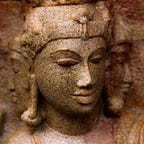Ancient Industries of Poompuhar…!
Puhar (also known as Poompuhar), பூம்புகார் is a town in Nagapattinam district in Tamil Nadu. It was once a flourishing ancient port city known as Kaveripoompattinam, which for a while served as the capital of the Early Cholas.
It is mentioned in the Periplus of the Erythraean Sea. Kaveripoompattinam was a beautiful maritime city of the Sangam age, situated at the confluence of the river Kaveri with the Bay of Bengal.
It served as the centre of Political, Cultural and Commercial activities of the Ancient Tamils. There were references of its flourishing trade, planned layout, beautiful building and harbour area from the early Tamil works such as Pattinappalai, Manimekalai and Silappathikaram.
The excavation conducted at Poompuhar confirmed the existence of a great Industrial Civilization dating back to 3rd Century BCE. The following are the next prominent industries that flourished in Poompuhar of ancient days.
Generally the professions of the artisans were hereditary. They inherit professional talents from their parents & their involvement in the art right from childhood must have helped them to attain a great degree of perfection. Silappathikaram mentions 32 different kinds of cloths.
Manimekalai also tells the artistic pattern of the expert weaving. The art of stitching fabrics of cotton, silk and wool was also known. All these stand as testimony to the early technical advancement in the art of weaving.
Ship Building
Wood carving was fairly well developed during the Sangam age. Several types of Tools, Weapons, Utensils, Furnitures, Toys, Boats, Ships and Chariots are stated to have been made by the Carpenters.
The Sangam literatures refers to the city of Puhar as the celebrated sea port! The ship building must have been one of the major industries of Puhar. The larger vessels were called as Marakkalam, while the small fishing boats as Kattumaram.
The epic Silappathikaram speaks different shapes of ships with faces like Horse, Elephant and Lion. It reveals the artistic outlook of the Tamils in as early as 2nd Century CE. According to Pattinappalai the ships standing in the port looked like huge Elephants.
Salt Industry was widespread all along the sea coast. In Pattinappalai there were many references.
Industry of Jewellery
A Variety of Jewels made of various materials are mentioned in the Sangam literature. Making of Beads, Bangles, Chain, Anklets is elaborately discussed.
The excavation has thrown more light on Bead making industry of Puhar. The Semi-precious Stone Beads, Shell Beads, Shell Bangle Pieces, Glass Bangle Pieces were unearthed from excavations.
The people who made bangles, rings and beads made out of conch shells, lived in parallel streets of the western side of the palace in Puhar city! They were called as “Vela parpans”. The sawed conches collected from the excavation corroborate the literary evidences.
Earthenware Industry
The art of pottery making and clay figurines is referred to in the ancient Tamil works like Silappathikaram and Manimekalai. The potters were known as Vetko.
Excavated trenches at Poompuhar have yielded different varieties of potsherds which proves the fact that pottery making was also an important industry of Puhar. A considerable number of terracotta figurines were found at a place called Melapperumpallam near Kaveripoompattinam.
This reveals that the potters had also made clay figurines. The artisans who made these figurines were called as Mannittalar. The brick structure, almost semi-circular in plan, exposed during excavation may be the same as Peraikeni mentioned in Sangam literature.
A Vihara complex built of burnt bricks was also exposed. All this attest the fact that the art of brick making was also known to the people of Puhar.
Mint
Some square copper coins bearing the royal crest of the Chola, i.e. the tiger on one side and the elephant on the other were found from Poompuhar. These prove the fact that the art of minting coins was very popular at Puhar.
The industrial workers of Puhar lived in Maruvurpakkam, a place where most of the industries were situated. It is found that the evidences strongly substantiate the literary references. The existence of number of industries at Puhar indicate that it was an urban settlement.
